FEATURES|THEMES|Philosophy and Buddhist Studies
A Journey Through the Guru’s Name Mantra
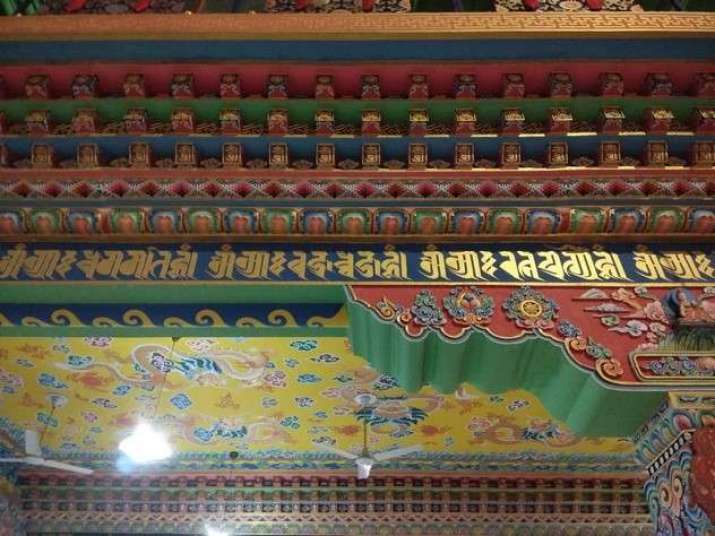 Image courtesy of Bem Mitruev
Image courtesy of Bem MitruevBem Mitruev works at the Kalmyk Scientific Center, Russian Academy of Sciences. In this comprehensive article, he outlines the criteria that constitute a legitimate name mantra for a Vajrayana master, and the many religious and linguistic considerations that a name mantra involves. Name mantras are extremely important practices in Vajrayana Buddhism, but are often subject to erroneous construction and misinterpretation.
Name mantras (Tib: mtshan sngags) are a core feature of Vajrayana Buddhism. They are mantras that were popular across Tibetan society and in all traditions of Vajrayana Buddhism. But before we ask how name mantras are created, we need to know who meets the exalted status of being called a spiritual master, and whether a mantra for their name is worth creating at all.
His Holiness the 17th Karmapa Orgyen Trinley Dorje was very specific about this in one of his interviews: “‘The practice of guru’ and the ‘offering to guru’ are made to please the mind of the teacher. For this sake, the three kinds of vows (the vows of personal liberation, the bodhisattva vows, and the tantric vows) are practiced in an appropriate way, with the guru in the teaching of the secret mantra as the lord of the mandala (the mandala master is the central deity in the mandala, in the form of whom the teacher appears during initiation). This is stated in the explanation of the four initiations.” (Kagyu Monlam)
His Holiness has stated that many people make up the mantras of their teachers without following the way it is stated in the tantras. One such example is Oṃ Vajra Tashi, which is an incoherent mix of Sanskrit and Tibetan. All of these clearly indicate that it is an incorrect mantra. Teachers that accept these mantras, instead of spreading Dharma that benefits the mind or the practice of the three kinds of vows, instead call themselves Vajradhara Guru and utter only false words. This cannot be called true or good Dharma.
In other words, the sad reality is that very often so-called gurus are not worthy spiritual guides, and their misled students attempt to incorrectly create mantras for them, which are themselves linguistically flawed and erroneously mixing liturgical languages. Such false gurus are spoken of in the third verse of the Initiations chapter of the Kalachakra Tantra:
Proud, ruled by anger, and lacking vows,
greedy, without knowledge, working to deceive disciples,
a mind that has fallen from great bliss,
without initiation, totally attached to wealth,
unaware, of harsh and coarse words, filled with carnal desire,
the wise disciples should abandon taking such people
as causes of complete enlightenment as they would abandon hell.
People with such faults are not fit to be relied upon as gurus in the Vajra Vehicle. Even if one takes such a person as a guru and requests initiations and so forth, there can be no meaningful receiving of the initiation. (Gyatso 2004, 214–15)
In this passage of the Kalachakra Tantra, one is told who cannot be considered a true spiritual guide and that so-called "spiritual guides" are to be avoided. The text goes on to narrate the divisions of gurus:
These characteristics may be further divided into those possessed by a fully ordained monk, those possessed by a novice monk, and those possessed by a layperson. Among these three types of persons worthy of being a vajra master, a fully ordained monk is the best, a novice monk is second best, and a layman the lowest of the three. Therefore, when all three are present, it is the fully ordained monk that one should rely upon as one’s guru. Moreover, kings should rely upon fully ordained monks as gurus, because if they rely upon laymen, it will bring harm to the teachings. How will this happen? If a layman is taken as a guru even though a fully ordained monk worthy of being a vajra master is accessible, the people will lose respect for the Buddha, Dharma, and Sangha, which in turn will lead to the disappearance of the doctrine. The Great Commentary, on the second verse of the Initiations chapter, quotes passages that say:
“Of the three who know well the ten activities,
the full monk is the best,
the novice is second best,
the householder the lowest.” (Gyatso 2004, 213–14)
Before creating the mantra of any of the teachers we consider our guru, it is necessary to make sure that this person is indeed worthy of being a teacher. He or she needs to possess all the necessary characteristics. These characteristics are given in the Sūtra Adornment (Skt: Sūtra-alaṃkāra; Tib: mdo sde rgyan):
Rely on a Mahayana teacher who is disciplined, serene, thoroughly pacified;
Has good qualities surpassing those of the students; is energetic; has a wealth of scriptural knowledge;
Possesses loving concern; has thorough knowledge of reality and skill in instructing disciples;
And has abandoned dispiritedness. (Tsong-kha-pa 2000, 71)
These are 10 characteristics that a teacher should possess. At the very least, he or she should have qualities that are superior to those of the student. It makes no sense to rely on someone who has less merit and accumulated wisdom than oneself. Moreover, the teacher must have realization of reality, if not directly, then at least a good knowledge of what reality is. Continuing this quote, Lama Tsongkhapa says in the Lamrim:
Thus, Maitreya says that a student must rely on a teacher who has these ten qualities. It is said that those who have not disciplined themselves have no basis for disciplining others. Therefore, gurus who intend to discipline others' minds must first have disciplined their own. (Tsong-kha-pa 2000, 71)
“Good friend” (Skt: kalyāṇamitra) means the spiritual master or guru. Since this is a name mantra, it must be remembered that mantras must be pronounced correctly. The Sutra of Subāhu Question (Skt: Subāhuparipṛcchāsūtra; Tib: dpung bzang gis zhus pa'i rgyud) states:
While muttering, one should be neither hurried nor slow,
Neither too loud nor too low,
Neither speaking nor distracted,
Nor disregarding the upper and lower vowel signs, the anusvāra, or the visarga. (Lessing, Wayman 1978: 189–91)
The last line suggests that the mantra should be pronounced without losing “anusvāra and visarga.” That is, the mantras must be pronounced without twisting or mispronouncing them, as is very often the case, for example, in Tibetan, Chinese, and other traditions.
What is the guru’s name mantra needed for? And even if a guru mantra is created, how do you use it? These mantras are used primarily for two purposes: to supplicate the gurus of the lineage and to supplicate the root gurus.
Using the mantra to supplicate the gurus of the lineage
Often, one finds texts in which the mantras are found in a successive order, and these are all the mantras of the text’s lineage teachers. When these mantras are recited, one recalls these gurus, performs their visualization in the field of merit accumulation, in the space in front of oneself, and so on. There are also somewhat different mantras from those mentioned above, which are mantras for supplicating root gurus. Such a mantra is often included in the text of guru yoga, which is the practice of union with the root guru. This mantra is often preceded by a short eulogy or praise addressed to that teacher. These kinds of guru mantras exist both in the tradition of the old translations, Nyingma (Tib: rnying ma), and in allnew translation schools, Sarma (Tib: gsar ma): Gelug, Sakya, Kagyu, and Jonang.
For example, this text is by the third incarnation of Detri Tulku Jamyang Tubten Nyima (Tib: sde khri sprul sku 'jam dbyangs thub bstan nyi ma; 1779–1862) from the Gelukpa monastery Lawrang Tashi Khyil.
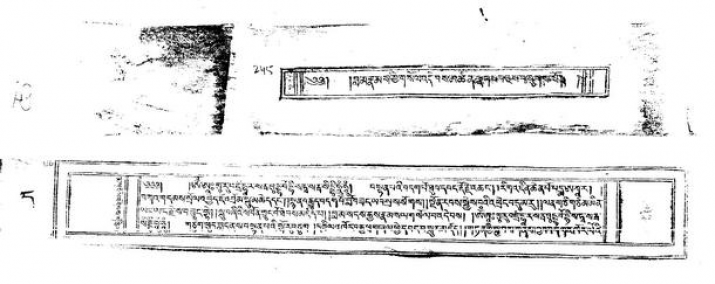 Image courtesy of Bem Mitruev
Image courtesy of Bem MitruevThe title of this text is A Collection of Name Mantras and Guru Supplication Prayers. In this text, the first line is the mantra: Oṃ āḥ guru Vajradhara sarva-buddha-bodhisattva sarva siddhi hūṃ hūṃ. What follows after the first line is the supplication prayer to the guru, and again the mantra of that master. The first mantra contains a supplication to all the buddhas and bodhisattvas. It is afterwards that the supplication prayers to the relevant master appear.
 Image courtesy of Bem Mitruev
Image courtesy of Bem MitruevAbove is a text from the Drikung Kagyu tradition. At the top is the title, which reads: A Cycle of Supplication Prayers and Praises Related to the Biographies of the Precious Masters of the Drikung Kagyu Lineage. (Tib: bla ma brgyud pa'i mtshan sngags/'bri gung bka' brgyud chos mdzod chen mo)
The first mantra reads: Oṃ āḥ guru Vajradhṛk siddhi phala hūṃ. Oṃ āḥ guru Prajñyabhadra siddhi phala hūṃ. Oṃ āḥ guru Jñanasiddhi siddhi phala hūṃ.
What follows are the Sanskrit names of the teachers of the lineage of succession. Each name follows after the other, and when reading this text, the reciter requests these invoked teachers to bestow their blessings.
Another such text of the Nyingma tradition is called Collected Works by Nyingma Master Ngawang Tenzin Norbu. It was authored by Nyingma master Ngawang Tendzin Norbu (1867–1940), is also known as Rongphu Sangye (Tib: rong phu sangs rgyas) or Rongphu Sangye of the Dza region. (Tib: rdza rong phu sangs rgyas)
 Image courtesy of Bem Mitruev
Image courtesy of Bem Mitruev Image courtesy of Bem Mitruev
Image courtesy of Bem MitruevAbove is a collection of mantras that opens with a quatrain of worship, followed by a mantra addressed to one of the teachers. Beneath the Tibetan letters are signs of small crescents with circles above them. These signs indicate that the syllables make up the name of the teacher to whom the supplication prayer is directed. The first syllable is Rig (Tib: rig), and then the next syllable is Dzin (Tib: ’dzin), before being followed by two words, Gyur-me (Tib: ’gyur med), with the concluding syllables being Dor-je (Tib: rdo rje). Thus we can understand that this prayer is addressed to the teacher Rigzin Gyurme Dorje. The mantra that follows records his name in Sanskrit. His name, translated into Sanskrit, is fully included in the mantra: Oṃ āḥ guru Akṣaravajra siddhi hūṃ hūṃ. Akṣara means “changeless” (Tib. ’gyur med) and Vajra means “diamond” (Tib: rdo rje).
The mantra lacks the epithet Vidyadhara, but this is a common practice. Often, only a part of the entire name is translated.
 Image courtesy of Bem Mitruev
Image courtesy of Bem MitruevThe next teacher addressed in this text is Ngawang Chopel Gyatso (Tib: ngag dbang chos dpal). His mantra reads: Oṃ āḥ guru Vagindra Dharmaśrī Samudra siddhi hūṃ hūṃ. Vagindra is Sanskrit for the Tibetan Ngawang, “Lord of Speech,” Dharmaśrī means Chopel in Tibetan, or “Splendor of the Dharma,” and Samudra is Gyatso, or “Ocean.” In this case, the name of this teacher is fully integrated into the mantra.
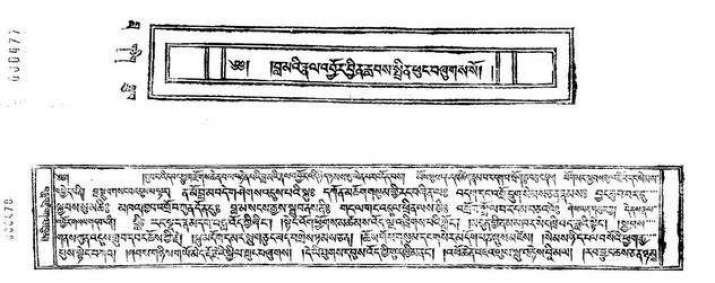 Image courtesy of Bem Mitruev
Image courtesy of Bem MitruevThere is a perception that guru yoga is a category or division of texts peculiar merely to the new translation schools, but this is not true. In fact, guru yoga exists in the older tradition of Nyingma as well. Furthermore, in Nyingma there is a category of texts called ladrub (Tib: bla sgrub), which means “guru practice” or guru sadhana. This guru sadhana is not too different from guru yoga. One of the earliest guru yoga texts on Virupa was written by Sachen Kunga Ningpo. (Tib: sa chen kun dga’ snying po) (The School of Oriental and African Studies)
Above is an example of Nyingma guru yoga: The Guru Yoga of the Masses of Clouds of Blessing (Tib: bla ma’i rnal ’byor byin rlabs sprin phung (bla sgrub), dedicated to the Dzogchen Khenpo Padma Vajra. (Tib: gsung ’bum/ rdzogs chen mkhan po pad+ma ba dz+ra)
The below text, which has name mantras from the Lamrim lineage, belongs to the Gelug tradition.
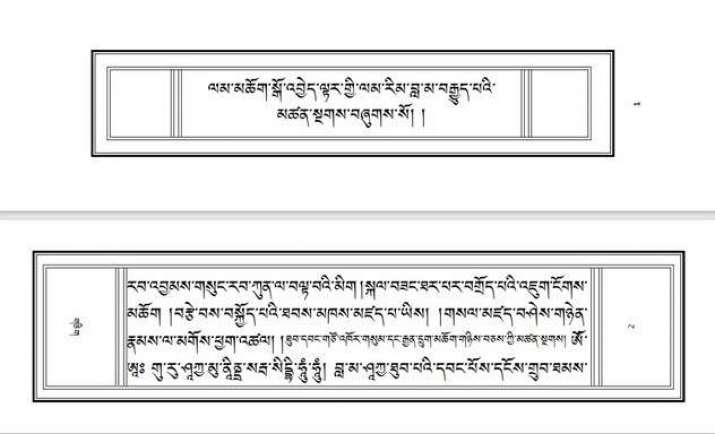 Image courtesy of Bem Mitruev
Image courtesy of Bem MitruevAs with the previous mantras, here we find a four-line supplication prayer to the master at the beginning, followed by the mantra: Oṃ āḥ guru Śākyamunīndra sarva siddhi hūṃ hūṃ. This mantra is addressed to the first figure in this line of succession, who is none other than the Lord of the Sages of the Śākya clan, Śākyamuni Buddha.
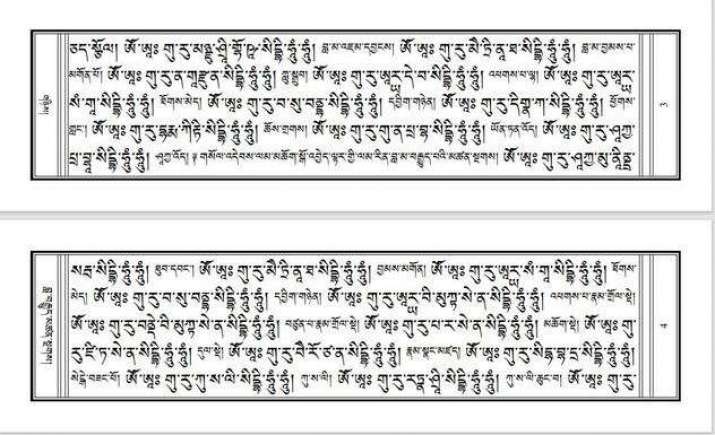 Image courtesy of Bem Mitruev
Image courtesy of Bem MitruevThe mantras below are addressed to the successive masters of the text’s lineage. For example, when we look at the first mantra: Oṃ āḥ guru Mañjuśrīghoṣa siddhi hūṃ hūṃ, we can deduce that this is the mantra of Mañjuśrī. The next, Oṃ āḥ guru Maitreyanātha siddhi hūṃ hūṃ, is the mantra of Maitreyanātha, the Protector of Maitreya. Then we have the following mantra, which reads: Oṃ āḥ guru Nāgārjuna siddhi hūṃ hūṃ. This is evidently a supplication to the guru Nāgārjuna.
In this respect, composing mantras for Indian teachers is much easier, because they usually have Indic names that do not need to be translated back into Sanskrit. With the Tibetans, however, the matter is somewhat more complicated.
Below is the mantra: Oṃ āḥ guru Guṇaprabha siddhi hūṃ hūṃ. This is the mantra of one of the Six Ornaments of Jambudvīpa; specifically, Guṇaprabha the Vinaya Holder. Therefore, this text is a supplication to all the teachers of the deep and extensive lineages of the Lamrim.
The mantras below are addressed to the successive masters of this lineage. For example, the mantra: Oṃ āḥ guru Mañjuśrīghoṣa siddhi hūṃ hūṃ. As one can easily guess, this is the mantra of Mañjuśrī. Oṃ āḥ guru Maitreyanātha siddhi hūṃ hūṃ is obviously the mantra of Maitreyanātha, the Protector of Maitreya. One of the following mantras is Oṃ āḥ guru Nāgārjuna siddhi hūṃ hūṃ. As is evident from the mantra itself, it is a supplication to the guru Nāgārjuna.
In this respect, composing mantras for Indian teachers is much easier, because they usually have Indian names that do not need to be translated back into Sanskrit. With the Tibetans, however, the matter is somewhat more complicated.
Below is the mantra: Oṃ āḥ guru Guṇaprabha siddhi hūṃ hūṃ. This is the mantra of one of the six ornaments of Jambudvīpa, Guṇaprabha the vinaya holder. Thus, this text is a supplication to all the teachers of the deep and extensive lineages of the Lamrim.
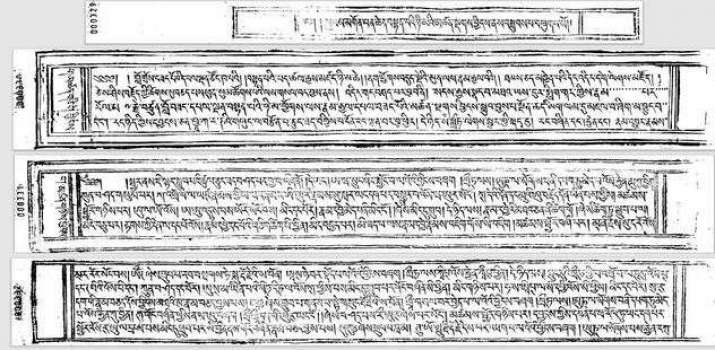 Image courtesy of Bem Mitruev
Image courtesy of Bem MitruevThe next text presented below, The Formation of the Word Types of the Name Mantra of Refuge and Protector Tenpe Nyima (Tib: skyabs mgon bstan pa'i nyi ma'i mtshan sngags byings nas bsgrubs pa), explains how the words that make up the mantras are formed, relying on the rules of Sanskrit grammar.
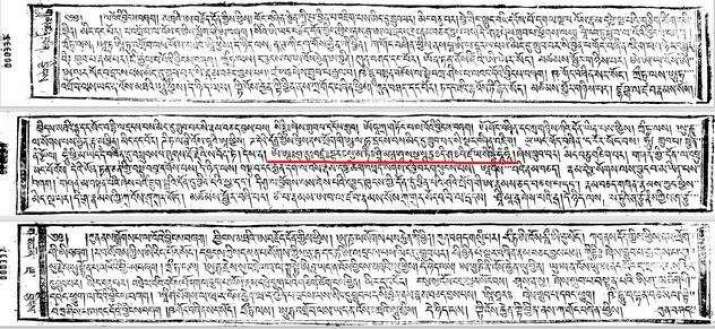 Image courtesy of Bem Mitruev
Image courtesy of Bem MitruevThe whole text is not our core concern, but the red line here is the core of this mantra: Oṃ āḥ guru Vajradhara Sumati Śrīmān Śāsasya Sūryaḥ Diśaḥ Vijaya siddhi hūṃ hūṃ. The mantra is technically misspelled, but in this case it does not matter. What matters is how this example illustrates the process of translating, or rather reconstructing in Sanskrit, the words included in the mantra. It is considered a restoration because most of the spiritual and monastic names are translations from Sanskrit and have been borrowed from the Indian tradition. This text indicates that there were people in Tibet who knew enough Sanskrit grammar to be relatively successful in restoring Sanskrit proper names. It is not entirely clear how well they could compose texts in Sanskrit, however.
Modern Tibetan commentarial works on Sanskrit grammatical texts assert that the tradition of studying Sanskrit grammar in Tibet is still alive, with modern Tibetan scholars still composing commentaries on grammatical treatises. An example of how this tradition lives on is the composition and use of name mantras in the design of religious structures.
For example, there is a beautifully decorated monastery in Bodh Gaya, India, that belongs to Yonge Mingyur Rinpoche (Tib: yongs dge mi 'gyur rin po che) of the Karma Kagyu tradition. It is called Tergar (Tib: gter sgar) or Pel Tergar Rigdzin Khacho-ling (Tib: dpal gter sgar rig ’dzin mkha’ spyod gling), which in English translates to “the magnificent camp of Terton* and ‘Abode of knowledge holders traveling through the sky.’” Inside the monastery, one can see name mantras written in gold letters in the calligraphic Lañja script on the entablature above the columns.
Let us examine some of these mantras. These are the mantras of the teachers of the Mahāmudrā lineage. There is a “Supplication prayer to the Mahāmudrā masters” (Tib. phyag chen brgyud pa’i gsol ’debs) in which all the teachers of this lineage are listed. The mantras discussed here are dedicated to the masters of this devotional prayer.
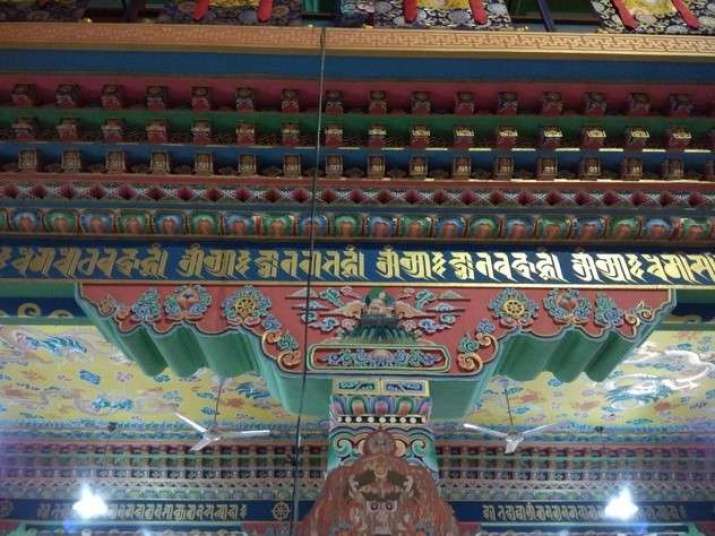 Image courtesy of Bem Mitruev
Image courtesy of Bem MitruevThe first mantra we see in the above photo is Oṃ Prajñabhadra hūṃ.
The Tibetan text of the supplication prayer says, “Tilopa Prajñabhadra, know!” (Tib: tai lo shes rab bzang po mkhyen no//) Just as in this prayer, the address to the teacher of the lineage of succession is made through a mantra. Prajñabhadra is the spiritual name of Tilopa, who was a great scholar of Nalanda University. Prajña means “wisdom” and bhadra means “good.” Thus, one can quote his name as “Good Wisdom.”
It is possible to find out from the mantra who it is addressed to, but only if we know the context and the line of succession to which it is addressed.
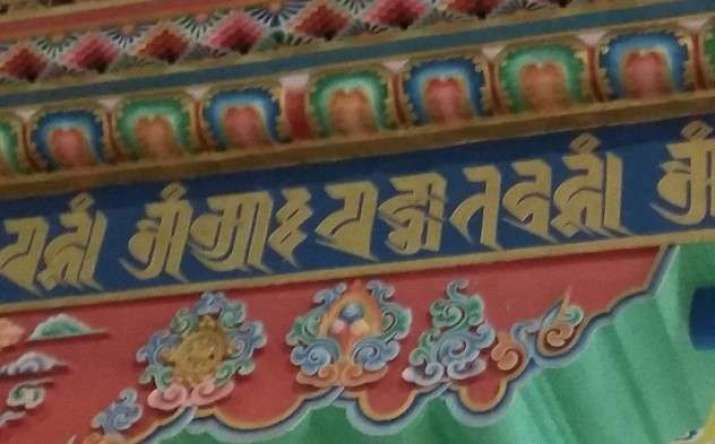 Image courtesy of Bem Mitruev
Image courtesy of Bem Mitruev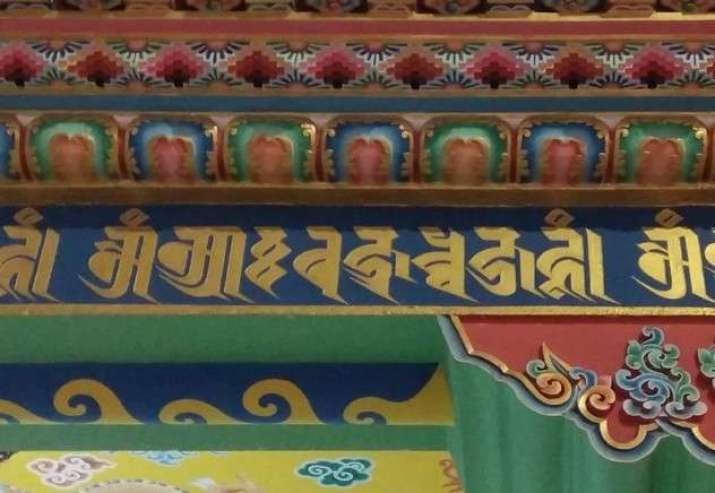 Image courtesy of Bem Mitruev
Image courtesy of Bem MitruevThe next mantra we see in the image above is Oṃ āḥ Vajradhvaja hūṃ Vajradhvaja (Tib: rdo rje rgyal mtshan), or Vajra Standard of Victory. This is the name given to the famous yogi Milarepa by his teacher Marpa Lotsawa, after he first transmitted to his disciple the lay and bodhisattva vows.
As we can see from this example, it is crucial to understand to whom the mantra is addressed and how it was formed. For example, next in the same lineage of succession is Gampopa (Tib: sgam po pa), who was also called Da Ö Shonnu (Tib: zla 'od gzhon nu), “Young Man of Moonlight.” However, another name that belongs to him, Sonam Rinchen (Tib: bsod nams rin chen), is more famous. Quite often the masters had several names, which were used on different occasions.
Gampopa’s mantra is as follows: Oṃ āḥ Ratnapuṇya hūṃ. There is no doubt that this is a translation of Gampopa’s name, but the order of the name’s elements has been changed in the image above. Instead of Puṇyaratna, which corresponds to the order of words in the Tibetan name bsod nams rin chen, the order here is reversed: Ratnapuṇya, “Jewel of Merit,” which corresponds to the Tibetan rin chen bsod nams. In Tibet, when reconstructing the name in Sanskrit, sometimes the elements of the name were rearranged. In the case of Puṇyaratna, the attribute of puṇya comes first and the dependent member ratna comes second. Therefore, it is translated as “Jewel of Merit.” In the case of the name Ratnapuṇya, the attribute is ratna and the dependent member is puṇya, which causes it to be translated “Precious merit.” The order of the words is significant.
The next mantra is addressed to the First Karmapa Dusum Khyenpa (Tib: Kar ma pa dus gsum mkhyen pa; 1110–93), “Knower of the Three Times”: Oṃ āḥ trīkālajña hūṃ.
The next invocation is to the first incarnation of Situ Drogon Sangye Rinchen (Tib: si tu 'gro mgon sangs rgyas ras chen; 1088–1158). His mantra is written incorrectly as: kirati instead of the word kīrti. The result is his mantra: Oṃ āḥ Buddha kīrati [kīrti] hūṃ.
But why is he addressed as Buddhakīrti? The answer lies in one of his names, which was Sangye Peldrak (Tib: sangs rgyas dpal grags). That name was translated into Sanskrit for use, with Sangye corresponding to buddha and drak to kīrti. Therefore, it is important to know what names a particular teacher might have had in order to correctly identify the recipient of the mantra.
The next teacher is Pomdrakpa Sangye Dorje (Tib: spom brags pa sangs rgyas rdo rje) (1170–1249). His mantra is Oṃ āḥ Puṇyai vajra hūṃ. The word Puṇyai is misspelled. It seems like Puṇyai is Puṇya in the Instrumental case, with a missing visarga (an allophone in Sanskrit phonology). This mantra seems to lack the proper phonetic transposition of the name elements.
The next teacher we find is the Second Karmapa Karma Pakshi (Tib: kar+ma pak+shi) (1204/6–83). It is commonly believed that Pakshi is a Mongolian word, but etymologically it comes from the Chinese “boshi” (Chin. 博士; pinyin. bóshì). This is a Chinese word meaning senior scholar, chief erudite. In contemporary Chinese discourse, it is used to designate anyone with a doctorate.
Karma Pakshi’s mantra is Oṃ āḥ Karmapakṣi hūṃ. In the mantra, the word Pakṣi has not been translated. Karma is the Sanskrit word, so there is no need to translate it.
The next teacher is Kedrub Orgyenpa (Tib: mkhas grub o rgyan pa) (1230–1312). His mantra is Oṃ āḥ Odyīna hūṃ. Orgyenpa (Tib: o rgyan pa) means “master from Uddiyana.” The Tibetan o rgyan, which in the Sanskrit original is Uḍḍiyāṇa or Uḍḍiyāna, was incorrectly written in the mantra as Odyīna.
Next is the Third Karmapa Rangjung Dorje (Tib: rang byung rdo rje; 1284–1339). His mantra is Oṃ āḥ Svayaṃbhūvajra hūṃ. Svayambhū means “self-revealed,” while vajra means “diamond.”
The next teacher we see here is Gyalwa Yungtonpa Dorje Pel (Tib: rgyal ba g. yung ston rdo rje dpal; 1296–1376). His mantra is Oṃ āḥ Vajraśrī hūṃ. Out of Gyalwa Yungtonpa Dorje Pel’s name, only Dorje Pel’s Vajraśrī component is used in the mantra, which means “Vajra Splendor.”
Next is the Fourth Karmapa Rolpe Dorje (Tib: rol pa’i rdo rje; 1340–83). His other name is Dzamling Choki Drakpa (Tib: ’dzam gling chos kyi grags pa). The first name used for the mantra was Rolpe Dorje, or “The Playful Vajra.” The second name, Dzamling Choki Drakpa, can be translated as “The Glory of Dharma of Jambudvipa.” His mantra is Oṃ āḥ alala vajra hūṃ. This mantra is interesting because the Tibetan interjection a la la, expressing joy, is used to translate the Tibetan word rol pa, meaning “play” or “game.” This interjection in Sanskrit usually corresponds to the Sanskrit “aho.” There could be several Sanskrit equivalents of the Tibetan rol pa or “play” or “playing,” which appear in the names of various Indic Buddhist teachers. These equivalents are: līlā, vilāsa, lalitāḥ. Therefore, this mantra has been assembled incorrectly as well.
The next mantra is the Second Shamarpa Togden Kacho Wangpo (Tib: rtogs ldan mkha’ spyod dbang po; 1350–1405). His mantra is Oṃ āḥ Khageśvara hūṃ. Kacho Wangpo corresponds to the Sanskrit Khageśvara, or “Lord of those traveling in the sky.” The name “one who travels in the sky” usually means the spiritual beings known as ḍakinis.
These diverse mantras are all examples of supplication to lineage masters through the use of a name mantra.
2. The use of a mantra to supplicate the root gurus
Among the mantras given above is Milarepa’s mantra: Oṃ āḥ Vajradhvaja hūṃ. That is, this mantra is used to supplicate Milarepa as a lineage master. There are other mantras used to address Milarepa beyond the context of addressing him as the lineage master. In such instances we see that he is the sole figure to whom the practice is directed.
There are several Milarepa guru yoga texts. For example, there is the guru yoga titled, Guru Yoga Relying on the Great Milarepa in Cotton Robes, Together with the Offering of a Feast, “Shining splendor of supreme wisdom” (Tib: rje btsun ras pa chen po la brten pa’i bla ma’i rnal ’byor tshogs mchod dang bcas pa ye shes dpal ’bar). It was written by the First Kongtrul Karma Ngawang Yonten Gyatso (Tib. kong sprul karma yon ngag dbang yon tan rgya mtsho; 1813–99). In this guru yoga his mantra is Oṃ āḥ guru hāsavajra hūṃ.
This mantra is constructed somewhat differently from the above mantras supplicating the lineage masters. The words Oṃ āḥ guru are added here. There is another spiritual name of Milarepa’s that is used: Shepa Dorje (bzhad pa rdo rje/ bzhad pa’i rdo rje), which means “Laughing Vajra” or Hāsavajra in Sanskrit. The translation of this mantra is “Oṃ āḥ master Laughing Vajra.” The syllable hūṃ has many meanings, but in this context it means, “Grant siddhi! [perfection, accomplishment, or succcess].”
There are several Milarepa mantras. One is: Oṃ āḥ guru hāsavajra sarva siddhi phala hūṃ. Its translation is: “Oṃ āḥ master Laughing Vajra, grant me all siddhi hūṃ.” Sarva means “all,” siddhi means “spiritual attainments.” The word siddhi should be in the plural, but here it is in the singular. Here, Phala indicates the imperative of the Sanskrit verb phal, “to bestow,” and not the noun phala, which means “fruit, result.”
Among the mantras of teachers found in the texts of Buddhist Tibetan practices is the mantra of Guru Padmasambhava. It is also a guru mantra. The mantra of Guru Padmasambhava is Oṃ āḥ hūṃ Vajraguru Padma siddhi hūṃ. Its translation is “Oṃ āḥ Vajra Master Padma[sambhava], grant siddhi!”
In this mantra, “Oṃ āḥ hūṃ” is a reference to the body, speech, and mind of Vajraguru Padma, or Guru Padmasambhava. “Vajraguru” or “Vajra preceptor” is an epithet of Guru Padmasambhava. “Padma” indicates his name. The meaning of siddhi hūṃ is the same as above. There is little difference in structure between Padmasambhava’s mantra and Milarepa’s, so it can also be argued that this consistency is a feature of the guru’s name mantra.
In the text The Daily Practice, Ritual of Initiation, and Explanation of the Sixteen Precious Drops of the Kadam Tradition, “The Excellent Statement of the Ornament of Intention” (Tib: bka’ gdams rin po po che thig le bcu drug gi rgyun khyer dbang khrid kyi legs bshad phul byung dgongs rgyan), which was written by the Fifth Dalai Lama Ngawang Lobsang Gyatso (Tib: rgyal dbang lnga pa ngag dbang blo bzang rgya mtsho; 1617–82), the 11th section contains this mantra of Atiṣa: Oṃ mahāguru Dīpaṃkara Atiṣa svāhā.
Its translation is: “Oṃ Great Master Excellent Torch, set the foundation.” Atiṣa is “Excellent,” while Dīpaṃkara is “Torch” or “Illuminator.” In the Tibetan tradition svāhā is translated as gzhi tshugs. “Set the foundation” apparently implies the foundation for all goodness. This mantra is somewhat different from the previous ones. It contains the epithet which is not found in the preceding examples: mahāguru, or great teacher. From this we can conclude that the reference to the teacher may sometimes vary: teacher, great teacher, vajra teacher, and so on.
Another example is the text from the Yutog Nyingtik cycle (Tib: g.yu thog snying thig) named The Practice of the Master of Life, the Destroyer of the Demons of Master of Death (Tib: tshe dbang ’chi bdag bdud ’joms kyi sgrub pa), where this mantra is present: Oṃ mahāguru Vajrāyuḥsiddhi phala hūṃ hoḥ. Its translation is as follows: “Oṃ Great Teacher, with joy grant the attainment of vajra life force!” The syllable hoḥ is usually interpreted as an interjection expressing joy.
Other ways of supplicating the root guru
The following example is a mantra from the guru yoga The Unsurpassed Method of Achieving Great Bliss, dedicated to Bokar Rinpoche (Tib: Bokar Tulku Karma Ngedon Chokyi Lodro ’bo dkar sprul sku karma nges don chos kyi blo gros) (1940–2004). This was written by the 17th Karmapa Orgyen Trinley Dorje: Oṃ āḥ guru Vajradhara hūṃ. Its translation is, “Oṃ āḥ master Vajraholder, grant siddhi!”
From this example, one can see that in some cases, shorter guru yoga texts ask the guru to bestow siddhis as Vajradhara Buddha, without any epithets.
Another guru yoga is the Third Jamgon Kongtrul Karma Lodre Chokyi Sengge’s (Tib: karma blo gros chos kyi seng ge; 1954–92) Billowing Clouds of Blessing. It is interesting that the original text was written by the Second Kongtrul Pelden Kentse Oser Ngawang Chokyi Nyima (Tib: ’jam mgon sprul sku dpal ldan mkhyen brtse ’od zer ngag dbang chos kyi nyi ma; 1904–54). The text was then transformed by the Third Jamgon Kongtrul Karma Lodro Choki Sengge (b. 1954), into a practice in which his Sanskrit name is included in the mantra. The mantra of the Third Jamgon Kongtrul is as follows: Oṃ āḥ Vajraguru Mati Dharma Siṃha sarva siddhi hūṃ.
In this mantra, the Third Jamgon Kongtrul is addressed as Vajraguru, or Vajra preceptor. This kind of address is quite rare in guru name mantras. This address is identical to that used in the Guru Padmasambhava mantra, attesting further to the idea that the Padmasambhava mantra is a name mantra addressed to the guru.
Phrases and supplication prayer as mantras
In general, speech directed to the guru has the same function as asking for the bestowal of siddhi. The mantra has a definite structure consisting of a beginning, an invocation, a request for siddhi, and a conclusion. However, it can also consist of short phrases with a complete meaning, or be made entirely of supplication prayers. Such a phrase or stanza may not even begin with the syllable Oṃ, which is the universal beginning of the mantra. Moreover, even formal mantras, such as the mantra from the famous Prajñāpāramitā-hṛdaya-sūtra (gate gate pāragate pārasaṃgate bodhi svāhā), lack the beginning in the form of the syllable Oṃ. Many mantras also lack the ending, often represented by the word svāhā or another mantric syllable. For example, His Holiness the 17th Karmapa has this mantra: Karmapa kyenno! (Tib: karmapa mkhyen no).
At one of his teachings, His Holiness explained how this Karmapa mantra, repeated during Karmapa’s guru yoga, came into being:
“It is difficult to say when it came about . . . but it seems that even before Buddhism spread in Tibet, the people had the custom of invoking their many gods with ‘Khyenno’ (‘Know me’) or ‘Zig’ (‘See me’). When Buddhism developed in Tibet, this custom was gradually transferred over to the new spiritual path. We know at least, he said, that this happened after the time of the Fifth Karmapa, Deshin Shekpa, because when he was in China, at the behest of the Ming Emperor, a compilation was made of the names and mantras of all the buddhas and bodhisattvas. Beneath the image of Deshin Shekpa was the six-syllable mantra of Avalokiteshvara and not Karmapa Khyenno. History relates that from this time dates the tradition of many people reciting the six-syllable mantra with the understanding that it relates to both the Karmapa and Avalokiteshvara.” (The Karmapa’s Office)
The phrase, “Lama, khyenno!” (Tib: bla ma mkhyen no), meaning: “Master, hear! Teacher, know!” This phrase is found in the texts “calling the master from afar.” (Tib: bla ma rgyang ’bod)
The phrase Karmapa Khenno is now used as a mantra that is recited many times on Vajrayana Buddhist rosaries.
An example of a supplication prayer or stanza used as a mantra is the prayer addressed to Lama Tsongkhapa Lobsang Dragpa (tsong kha pa blo bzang grags pa; 1357–1419), called “Migtsema” (Tib. dmigs brtse ma). It begins with a prayer to the bodhisattva of compassion: dmigs med brtse ba’i gter chen spyan ras gzigs (“Avalokiteshvara, the great treasury of compassion, not perceiving true existence”). Here is its five-line version:
dmigs med brtse ba’i gter chen spyan ras gzigs//
dri med mkhyen pa’i dbang po ’jam pa’i dbyangs//
bdud dpung ma lus ’joms mdzad gsang ba’i bdag//
gangs can mkhas pa’i gtsug rgyan tsong kha pa//
blo bzang grags pa’i zhabs la gsol ba ’debs//
Its translation is as follows:
Avalokiteshvara, the great treasure of objectless compassion,
Manjushri, lord of impeccable wisdom,
Lord of mysteries, destroying hordes of Mara,
Tsongkhapa, the precious crown of sages of the Land of Snow,
Lobsang Dragpa, I pray at your feet!
Traditionally, it is said that Lama Tsongkhapa presented this prayer with a dedication to his master Rendawa Shonnu Lodro (Tib. red mda’ ba gzhon nu blo gros; 1349–1412). The master, in recognition of Lama Tsongkhapa’s extraordinary achievements, returned the dedication, making it a supplication to his student instead.
Various versions with different numbers of lines (from 5–9) are used as Tsongkhapa’s mantra, though his formal mantra is as follows: Oṃ āḥ guru Vajradhara Sumatikīrti sarva siddhi hūṃ.
One of the arguments supporting the claim that “Migtsema” corresponds to Lama Tsongkapa’s formal mantra is the practice of recitation retreats, in which one repeats “Migtsema” in the context of Lama Tsongkapa’s guru yoga, One Hundred Deities of Tuṣita (Tib: bla ma’i rnal ’byor dga’ ldan lha brgya ma). This is one of the most famous texts dealing with meditative practices associated with Lama Tsongkhapa in the Gelug school. Tradition attributes the authorship of this text to Dulnagpa Pelden Sangpo (’dul nag pa dpal ldan bzang po; 1402–73). This prayer is repeated one hundred thousand times during such a retreat, thus make it equal to a mantra in its meaning and use.
The tradition of performing the Migtsema at the time of the arrival of a particular teacher at a particular place is interesting. The devout, lined up in rows, repeat this prayer, which symbolizes the need to perceive the teacher as inseparable from Lama Tsongkhapa.
Another supplication prayer utilised as a mantra is an supplication to Choje Sakya Pandita Kunga Gyaltsen (Tib: chos rje sa skya paN+Di ta kun dga’ rgyal mtshan) (1182–1251), the fourth Sakya patriarch:
shes bya thams cad gzigs pa’i spyan yangs pa//
’gro kun dge legs sgrub pa’i thugs rje can//
bsam yas phrin las mdzad pa’i stobs mnga’ ba//
’jam mgon bla ma’i zhabs la mgos phyag ’tshal//
Its translation is as follows:
Your wide-open eyes see all that can be known.
Out of compassion you perform virtue and goodness for all wandering beings.
You have the power to perform the inconceivable activities.
Guru Mañjunātha, I bow my head at your feet!
This prayer-address is repeated many times on the 14th day of the 11th month of the Tibetan lunar calendar, the anniversary of Sakya Pandita’s passing.
Examples of poorly composed mantras
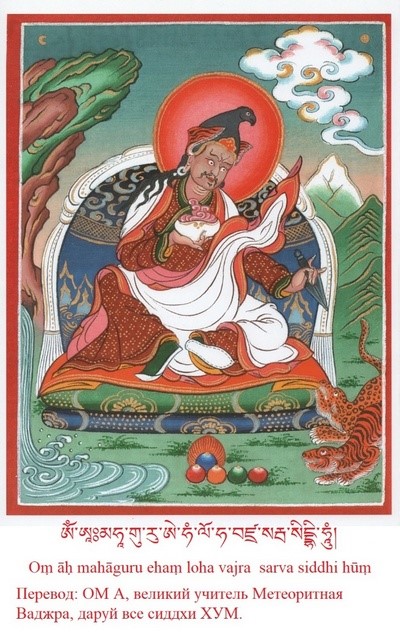
Image courtesy of Bem Mitruev
We have already looked at some examples of poorly composed mantras addressed to lineage masters, but there are other such cases as well. For example, this is the mantra of the famous terton Namchag Tsasum-lingpa (Tib: gnam lcags rtsa gsum gling pa; 1694–1738): Oṃ āḥ mahāguru Ehaṃ-loha-vajra sarva siddhi hūṃ. Its translation is “Oṃ āḥ, great master Meteorite Vajra, grant all siddhi hūṃ.”
The mahāguru address has already been discussed above. Ehaṃ-loha-vajra is the translation into Sanskrit of his name gnam lcags rdo rje, “Meteorite Vajra.” However, the word ehaṃ is not found in Sanskrit dictionaries. Knowing the Tibetan terton’s name “Meteorite Vajra” and given that loha means “iron” in Sanskrit, we can assume that ehaṃ corresponds to Tibetan gnam, “sky.” Thus, ehaṃ-loha denotes meteorite or “heavenly iron,” but this is an incorrectly restored Sanskrit word.
Another example of an unsuccessful translation is presented in the guru yoga of the 14th Shamar Mipham Chokyi Lodro (zhwa dmar mi pham chos kyi blo gros) (1952–2014), called “Feast of Achieving Blessing” (byin rlabs grub pa’i dga’ston). The mantra of the 14th Shamar is: Oṃ āḥ guru Bhagavan Dharmamati hūṃ svāhā. In this mantra, the Tibetan mi pham has been restored to Sanskrit as bhagavan, “Victorious,” but traditionally the Sanskrit equivalent of Maitreya Buddha’s epithet mi pham, “Undefeated,” is the word ajita. The word bhagavan corresponds to the Tibetan bcom ldan ’das. Another unusual feature is the word svāhā placed at the end of the mantra, which is rarely used in name mantras.
Thus, sometimes Tibetan word equivalents are chosen incorrectly and the mantra is poorly composed.
The use of name mantras
These kinds of mantras, addressed to a single major figure of practice, are used in guru yogas. Here is what His Holiness the Dalai Lama says about the use of name mantras in his commentary on the Guru Puja, called The Union of Bliss and Emptiness:
If you wish to do an abbreviated form of this practice, imagine that you are blessed by the guru and dissolve into clear light. From within that clear light, you arise into the primordial enjoyment body of the meditational deity in which you specialize.
After that, repeat the name mantras. At your heart and also at the heart of the central figure of the merit field, visualize the mantra circles: Oṃ āḥ hūṃ in the middle; then the mantra circle Oṃ āḥ Vajradhara siddhi hūṃ or Oṃ Vajradhara hūṃ (without siddhi). These are surrounded by Oṃ mune mune mahamunaye svāhā, or you can visualize Oṃ mune mune mahamunaye Śākyamunaye svāhā. Outside this is the name mantra of Lama Tsongkhapa: Oṃ guru Sumatikīrti siddhi hūṃ. The name mantra of the root guru should be recited at this point, as well. It is also good to recite all the name mantras of the gurus from whom you have received teachings directly. If you know the name mantra in Sanskrit you should recite that; if not, just insert the name between Oṃ āḥ guru Vajradhara and hūṃ. It is not necessary to frantically search for the Sanskrit names. If you do this practice daily, it will keep you acquainted with the number of gurus you have and keep you constantly aware of their kindness. Otherwise, if someone were to ask off-hand how many gurus you have, you would not be able to answer! (Dalai Lama 2009, 133)
In this passage, the Dalai Lama explains the method by which the guru’s name mantra is created. The mantra begins with the syllables Oṃ āḥ guru Vajradhara, followed by the guru’s name in Sanskrit. If the devotee cannot translate the name into Sanskrit, it is left in Tibetan. The mantra ends with the syllable hūṃ or the words sarva siddhi hūṃ. Thus Oṃ is an address to the body of the guru. It is often explained that Oṃ consists of three constituent sounds: a, u, ṃ, and thus symbolizes body, speech, and mind. Sometimes they are interpreted as symbols of the three bodies of the Buddha: nirmaṇakāya, saṃbhogakāya, and dharmakāya. But in name mantras, it is more likely that Oṃ symbolizes the body of the guru.
By uttering this syllable, the devotee asks for the blessing of the guru’s body. The syllable āḥ symbolizes the guru’s speech, Vajradhara and the guru’s name are an address to his mind, sarva siddhi hūṃ hūṃ or one hūṃ is a request to bestow all siddhis, both worldly and non-worldly (both ordinary and supreme). As stated above, the mantra may end with sarva siddhi, or just siddhi, or the syllable hūṃ, meaning “grant siddhi!”
As mentioned above, the supplication to the guru may also vary. Thus, the process of composing the name mantra of these mantras implies some flexibility. Mantras may vary from tradition to tradition, so the gurus are guided by previous examples of such mantras in a particular tradition when composing a name mantra.
Tibetan names, order, and translation
Let us take one example: the name of Tendzin Gyatso, the current Dalai Lama. His full name is Jampel Ngawang Lobsang Yeshe Tendzin Gyatso Pelsangpo (Tib. ’jam dpal ngag dbang blo bzang ye shes bstan ’dzin rgya mstho). Senior lamas in the Tibetan hierarchy often received very long names, which were included in full or abbreviated form in the mantra. If the lama is a monk, the word Bhaṭṭāraka, “Venerable,” to which the Tibetan rje btsun corresponds, is often placed before his name.
The Dalai Lama’s mantra is as follows: Oṃ āḥ guru Vajradhara Bhaṭṭāraka Mañjuśrī Vāgindra Sumati Jñāna Śāsanadhara Samudra Śrībhadra Sarva Siddhi Hūṃ Hūṃ. Its translation is: “Oṃ āḥ guru Vajraholder, Venerable Mañjuśrī, Lord of Speech, Good Mind, Supreme Wisdom, Holder of the Teaching, Ocean, Magnificent and Good, all Siddhi hūṃ hūṃ!”
Another example of a mantra that includes all of the teacher’s name is the mantra of Kundeling Rinpoche Tendzin Gyaltsen Pelsangpo (Tib: kun bde gling rin po che bstan 'dzin rgyal mtshan dpal bzang po). It is as follows: Oṃ āḥ guru Vajradhara Bhaṭṭāraka Śāsanadhara Dhvaja Śrībhadra siddhi Hūṃ Hūṃ. The translation of the mantra is: “Oṃ āḥ Guru Vajradhara, the Venerable Holder of the Teaching, the Standard of Victory, the Magnificent Splendor, grant siddhi!”
Thus, each element of a Tibetan name traditionally has a Sanskrit equivalent, of which it is a translation. Sometimes the names of incarnations of famous lamas or kings contain an element present in the names of all representatives of this lineage. For example, the Dalai Lamas, beginning with the Third Dalai Lama Sonam Gyatso, bear the name Gyatso, “Ocean.” The Dalai Lama’s name is Tendzin Gyatso. The kings of Sikkim bore the name Namgyal (Tib: rnam rgyal). Examples like this abound.
So how are traditional religious or spiritual names formed? In the monastic community, a name is given to a person at the time of taking monastic vows. The preceptor who bestows the vows gives the disciple part of his name. For example, many disciples of the 16th Dalai Lama are called Tendzin, regardless of gender.
From this we can conclude that there are some rules when creating a name mantra, although certain words cannot always be adequately translated. For example, if the first part of the name is Tendzin, the second part is selected from a wide list of possible variants, which may include the names of the six or ten pāramitās or another frequently used names. Sometimes this combination of name components simply will not work. For example, Tendzin Sopa (Tib: bstan ’dzin bzod pa) means the Holder of the Teaching-Patience. This name would most likely be translated as “Holder of the Teaching of Patience,” but it reads more like “Holder of the Teaching; Patience,” which sounds less poetic.
When reconstructing the Sanskrit equivalents of a Tibetan name, the order of the elements must be maintained. This was the case for our previous example of the name of Sonam Rinchen (Tib: bsod nams rin chen), where the order of the elements of the name was changed, and instead of Puṇyaratna, or “Merit-Jewel,” the name Ratnapuṇya, or “Jewel-Merit,” was composed, which is incorrect.
Another important issue is the correct selection of the reconstructed Sanskrit equivalents. For example, the Sanskrit equivalent of the name of an Indian scholar, Senge Sangpo (Tib: seng+ge bzang po), “Good Lion,” was recovered as Siṃhabhadra, but a Sanskrit text with his name was later discovered, and it was found that his name was actually Haribhadra, where Hari has the same meaning: “lion.”
When reconstructing the Sanskrit equivalents of Tibetan names, many variants for one name are possible. For example, the name nam mkha’, “space,” may have many synonyms: ākāśa, gagana, kha, and so on. Traditionally, the choice falls on the word that has been used more often in past for names of the members of the tradition. Such names, for example, may be the Sanskrit names of previous teachers.
Sometimes a teacher’s name is not taken as a whole name, but only the most familiar part of it. For example, the name mantra of the 41st Sakya Gongma Trichen Rinpoche Ngawang Kunga Tegchen Pelbar Trinle Sampel Wangyi Gyalpo (Tib. ngag dbang kun dga’ theg chen dpal ’bar phrin las bsam ’phel dbang gi rgyal po) uses only two elements of the name: Ngawang Kunga. The resulting mantra looks like this: Oṃ āḥ guru Vajradhara Vāgindrānanda sarva siddhi hūṃ.
Thus, knowing the structure of a name mantra allows one to not only create the mantra of a particular guru, but also to correctly attribute sacred qualities to the mantras already in circulation.
* Terton (Tib. gter ston) – lit., treasure revealer; a person who discovers gter ma or “treasure,” Tibetan Buddhist and Bon sacred objects, including a wide range of manuscripts, relics, statuary, and ritual implements, which are presumed to have been buried in earlier periods for discovery later. (Buswell, Robert E. Jr. and Lopez Donald S. Jr. 2014, 329).
References
Buswell, Robert E. Jr. and Donald S. Lopez Jr. 2014. Princeton Dictionary of Buddhism. Princeton: Princeton University Press.
Dalai Lama, The. 2009. The Union of Bliss and Emptiness: Teachings on the Practice of Guru Yoga. Ithaca: Snow Lion Publications.
Gyatso, Khedrup Norsang. 2004. Ornament of Stainless Light: An Exposition of the Kalacakra Tantra. Boston: Wisdom Publications.
Lessing, F. D. and A. Wayman. 1978. Introduction to the Buddhist Tantric Systems. Delhi: Motilal Banarsidass.
Sanzheev, G. D., L. R. Kontsevich, V. I. Rassadin, and J. D. Lehman (eds.). 2015. Etymological Dictionary of Mongolian Languages. Volume I. A–E. Institute of Oriental Studies of the Russian Academy of Sciences. Moscow: The Russian Academy of Sciences.
Tsong-kha-pa Blo-bzan-grags-pa. 2001. The Great Treatise on the Stages of the Path to Enlightenment. Volume One. Ithaca: Snow Lion Publications.
See more
དགེ་བཤེས་པོ་ཏོ་བའི་ཆིག་ལབ་རིང་མོའི་བཀའ་ཆོས་ཉིན་དང་པོ། [In Tibetan] (Kagyu Monlam)
Early guru yoga, indigenous ritual, and Padmasambhava (The School of Oriental and African Studies)
Direct Instructions on the Great Compassionate One, Day One (The Karmapa’s Office)
Related features from Buddhistdoor Global
The Path of the First Acharya in Russia: An Interview with Bem Mitruev, Part 1
The Path of the First Acharya in Russia: An Interview with Bem Mitruev, Part 2
The Path of the First Acharya in Russia: An Interview with Bem Mitruev, Part 3














